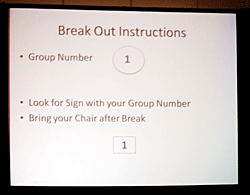Executing Effective Meetings
For a meeting to be productive it is important for the facilitator to:
- Set clear expectations
- Manage time
- Lead effective collaborative group decision-making
- Get participant feedback

Photo © Stephanie Wear/TNC
Setting Expectations
Key steps to setting clear meeting expectations include identifying:
- Specific objectives to be achieved at the meeting
- Participant roles, both before and during the meeting
- Setting realistic expectations for the time available
- Communicating clearly with participants to prepare for the meeting
It is also important to explain how input will be gathered and used—before, during and after the meeting. For example, will there be a final report or follow-up meeting or event? Participants should know if the decisions reached at the meeting will be final or if their input will be taken as a recommendation only.
Managing Time
Managing time effectively begins with assigning time limits to each topic or activity on the agenda. It is very helpful to practice activities or presentations before the meeting (when possible) to test the time assumptions. Be sure to coach all presenters on their time allocations and stress the need to stay on time.
It is helpful to appoint a timekeeper with the authority to stop people, with warning, when their time is up, along with providing a visible clock in the room. When managing time, an experienced facilitator often finds it useful to be flexible. During meetings, the facilitator may need to modify the agenda to achieve the meeting objectives. This includes determining what agenda items may be delayed or addressed in an alternate format (for example, delegated to a subgroup of participants, or to a single participant for further research or decision).
If the group discussion is taking longer than the allotted time, and there are concerns about not covering all items in the agenda, a good tactic is to review the key agenda items with the group and ask them how they want to use their remaining time. This often helps everyone get back on track.
Establishing Ground Rules
Establishing ‘ground rules’ is another key tool for running effective meetings. Although most ground rules are common sense, it is useful to draw participant attention to them at the beginning of a meeting. This establishes the group agreement on how they want to work together and helps prevent problems. Examples of ground rules include: no cell phones or pagers (or put them on silent/vibrate), returning on-time from breaks, everyone participates, no interrupting, showing respect for other participants, and focusing on the agenda item at hand. There are many other ground rules that can be used and it is often helpful for groups to decide on ground rules together at the beginning of a meeting.
Making Group Decisions
There are many methods available to aid groups in making decisions collaboratively. The most commonly used include brainstorming followed by clustering and voting; consensus decision making; consultation; and prioritization. For information on determining the appropriate process to aid groups in collaborative decision-making, see the guidance document Six Decision Making Options (pdf, 33k). See Facilitation Techniques for additional methods to help groups accomplish meeting objectives.
Getting Participant Feedback
To make future meetings more productive, it is helpful to collect evaluation information from meeting participants (e.g., using an evaluation form). There are many many methods for evaluating a meeting; for example, a “Plus/Delta” method includes asking participants to make positive comments about the meeting (plusses) and comments on changes that could be made to improve meetings in the future (deltas).
Navigating in Rough Seas excerpts are taken from NOAA training materials used in their Planning and Facilitating Collaborative Meetings